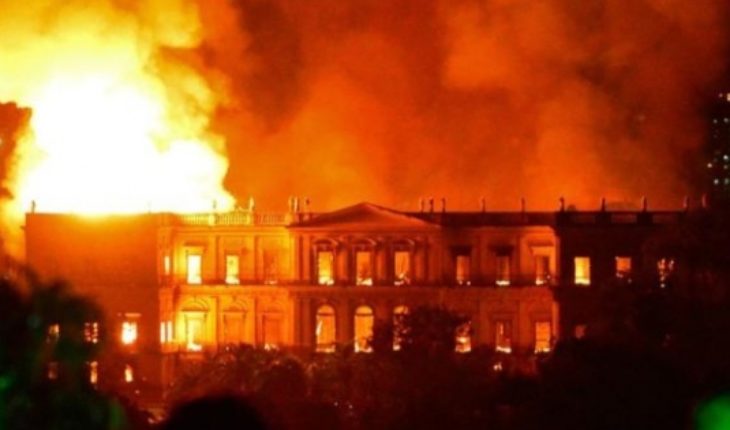so passed several ho RAS officials, teachers and technicians of the National Museum of Brazil during the moments in which burned this important institution of the city of Rio de Janeiro in the early hours of Sunday.
Professor Paulo Buckup joined a group that broke cabinets doors and managed to rescue from the fire so many drawers of molluscs as he could.
What caused the fire that destroyed the National Museum of Brazil?
The stunning images of the fire that consumed the National Museum of Brazil in Rio but this is only a small part of the inventory of tens of thousands of specimens of fauna of South America, mapped and stored in the collection of the Museum, where took place the serious a fire that destroyed most of the story which contained.
“These individuals were used in the original South American fauna of shellfish species descriptions, both marine and fresh water”, says Buckup.
“This material is unique because it is the basis for the species described during the last century. Without that, this record is lost”.
Buckup estimates have managed to save “some thousands” of specimens of mollusks, a quantity of “tiny” if one takes into account the scale of this collection.
“Lost I don’t know how many tens of thousands of insects such as, for example, all material from spiders and crustaceans”, says.
The fire in the National Museum of Brazil is a blow to the historic and cultural heritage of all the complex even more negligible considering the Andean mummies, the room furnishings of the Portuguese Empire, many databases, records of languages of villages that no longer exist .
What caused the fire that destroyed the National Museum of Brazil?
The Deputy Director of the Museum, Christian Serejo, said Monday, according to Brazilian media, that the flames had consumed about 90% of the parts of the place.
“Maybe 10% (of objects) is saved,” said, according to the portal Estadãoamong which are the meteorite of Bendegó, part of the library and some ceramic pieces.
“Things that no longer exist” the National Museum of Brazil – as well as being the greatest and oldest in the country – was home to one of the region’s largest collections of anthropology and natural history.
It was founded by Juan VI, King of Portugal exiled to Brazil, in 1818.
In 1892 he moved to the current address, Palacio de San Cristóbal, which served as a residence for the Portuguese royal family throughout the 19th century.
The Minister of culture of Brazil said that a reconstruction of the facilities will be caboActualmente the Museum is linked to the Federal University of Rio de Janeiro (UFRJ) and served as a headquarters to six courses, including those of Social Anthropology, Archaeology and zoology.
5 objects and “invaluable” collections of the National Museum of Brazil who was devoured by fire Buckup, who is part of the team of researchers from the Department of vertebrates of the UFRJ, said they felt “desolate” when talking to the BBC on the outside of the building, on the morning after the fire.
At that time firefighters still struggled to put out the fire, which was finally under control after about six hours of burning.
“The greatest loss the important ancient relics, things that are already there”, he says, citing a fish saw about five meters in danger of extinction that was being prepared to expose it to the public by its exoticism.
Buckup has it arrived at the scene about one hour after the start of the fire to try to safeguard some of the many “irreplaceable” pieces in the Museum.
“Paulo Buckup joined fellow to break doors and save from the flames which were possible.” It is regrettable. But firefighters did not have conditions to do nothing, to combat anything,”says.
“They had no water, they had no ladders, no equipment,” says the researcher.
“So we took the initiative to enter and try to save what was possible. We take the gates down and soldiers helped load the things,”he recalls.
Rescue Buckup believes that it is it could have saved more if the operation had been more agile.
And also if the Museum had had a policy of modernization of its buildings.
In 1996, the Department of vertebrates that owns this researcher was separated from the main building and obtained a new headquarters on the same street where the Museum is located: Quinta da Boa Vista, Rio de Janeiro. The same thing happened with the Department of Botany.
Both were saved thanks to that.
“At that time, the Government had the lucidity of investing in the preservation of our heritage, after supply dried and initiative was interrupted,” he says.
“I’m very sad for my colleagues, because some have 30 or 40 years of work here, and all that work is now lost.”
Combat operation to the flames was not Agilahora challenges Buckup see ahead are countless: accommodate researchers so that they can continue their activities, to accommodate all students of the UFRJ graduate programs, recover the research infrastructure and restore the building.
“Perhaps are the rubble some mineral and fossil, and that will require a complex work of rescue,” he says.
It remains to assess the real extent of the damage and begin work on the reconstruction of the Museum, according to the director of the institution, the archaeologist Alexander Kellner.
“Years ago we are struggling to get the resources that would have prevented what happened here today,” says.
“It is a sad day for Brazil, but we need to move forward”, he added.
translated from Spanish: National Museum of Brazil in Rio de Janeiro: researchers who entered the fire to rescue artifacts “irreplaceable”
September 5, 2018 |





